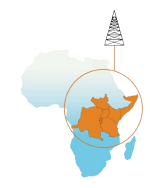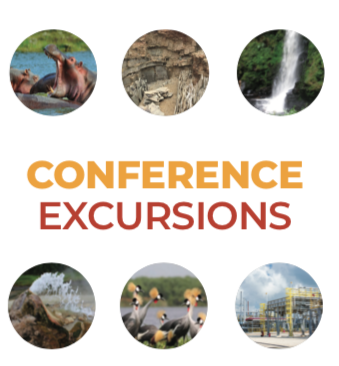ITINERARY: 8TH - 10TH MARCH, 2025
A three (3) day post-conference field excursion to the Southern Albertine graben is planned to take delegates through the Semliki Basin and Lake Edward-George basin, with the magnificent Queen Elizabeth National Park. The field trip will give the delegates the opportunity to observe the spectacular geology of these areas, visit the Sempaya hot springs and enjoy a tour of the Queen Elizabeth National Park.
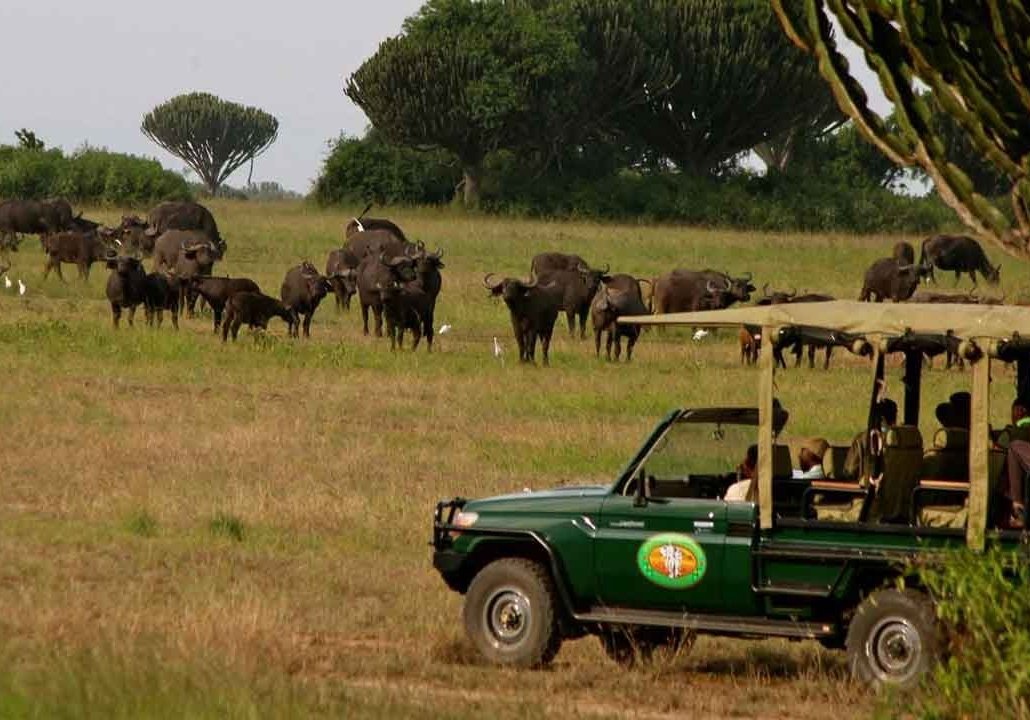
DAY 1: GEOLOGY OF SEMLIKI BASIN
Semliki basin is a half graben controlled by Congo master fault. On the Uganda side, a flexural opposing fault system exists. Data that has been acquired by Government of Uganda (gravity and magnetic) and oil companies (seismic and well) show thick sediment accumulations (depocenter) of up to 4km around the southern end of Lake Albert (Ntoroko area). This sediment burial could have generated and migrated hydrocarbons from potential organic rich source rocks into the surrounding structures that have been mapped. The south of the basin is occupied by the Rwenzori mountains which is regarded as the source and/or barrier to sediment escape from Semliki basin. Pickford and Senut (1994) dated surface exposures from this basin to be of Middle Miocene to recent whereas conflicting ages of Early Miocene (Lukaye, 2009) and Early Pliocene (RPS Energy, 2008) have been suggested for the Turaco well sections on the basis of palynomorphs. Subsequent mapping by the Department of Petroleum Exploration and Production indicates that these sediments are fluvial lacustrine deposits that have been grouped into Nyabusosi, Nyakabingo, Nyabugoro, Oluka, Kakara, Kasande and Kisegi Formations based on lithological properties and depositional environment.
Stop 1: Kichwamba observation point and Mungu ni Mukubwa.
Generally, a trip to Semliki has the most marvelous and breath-taking views. You will experience the thrilling meandering Bundibugyo Road through the Rwenzori escarpments. At “Munguna Mukubwa” while in the mountains, the road offers scenic views of the meandering Semliki River, fuming hot springs and the tropical rain forest extending to Ituri forest in the DRC. From this point, you will also enjoy a view of the raised surfaces of relay ramp structures on the other side in the DRC side that resemble the Kaiso Tonya structures of Uganda
Stop 2: Kibuku road cut and oil seep
Kibuku oil seep is located at the nose of Rwenzori mountains. At Kibuku, a characteristic paraffinic odour fills the atmosphere. The oil comes to surface through coarse to conglomeratic sandstone, which appears oil stained. Oil films cover most part of the Kibuku river and/or water pools during the dry seasons. The delegates will have an opportunity to discuss 120-150m good quality channel complexes exposed by the constructed road.
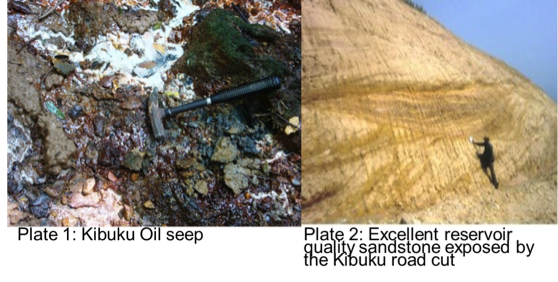
The medium-coarse grained well sorted sandstone demonstrates good reservoir characteristics within this part of the basin. The top most layer shows greenish-grey claystone. Weathered basement and basal conglomerates are other potential rocks.
Stop 3: Sempaya hot springs
The geothermal gradient within the EARS is obviously high as indicated by a vast number of hot springs. The geothermal gradient for the western arm of EARS is estimated at 67 to 73mW/m2. Estimates from Turaco have given 35oC/km. At Sempaya, hot water jets out at various locations resulting into clouds of steam in the area, at 100oC
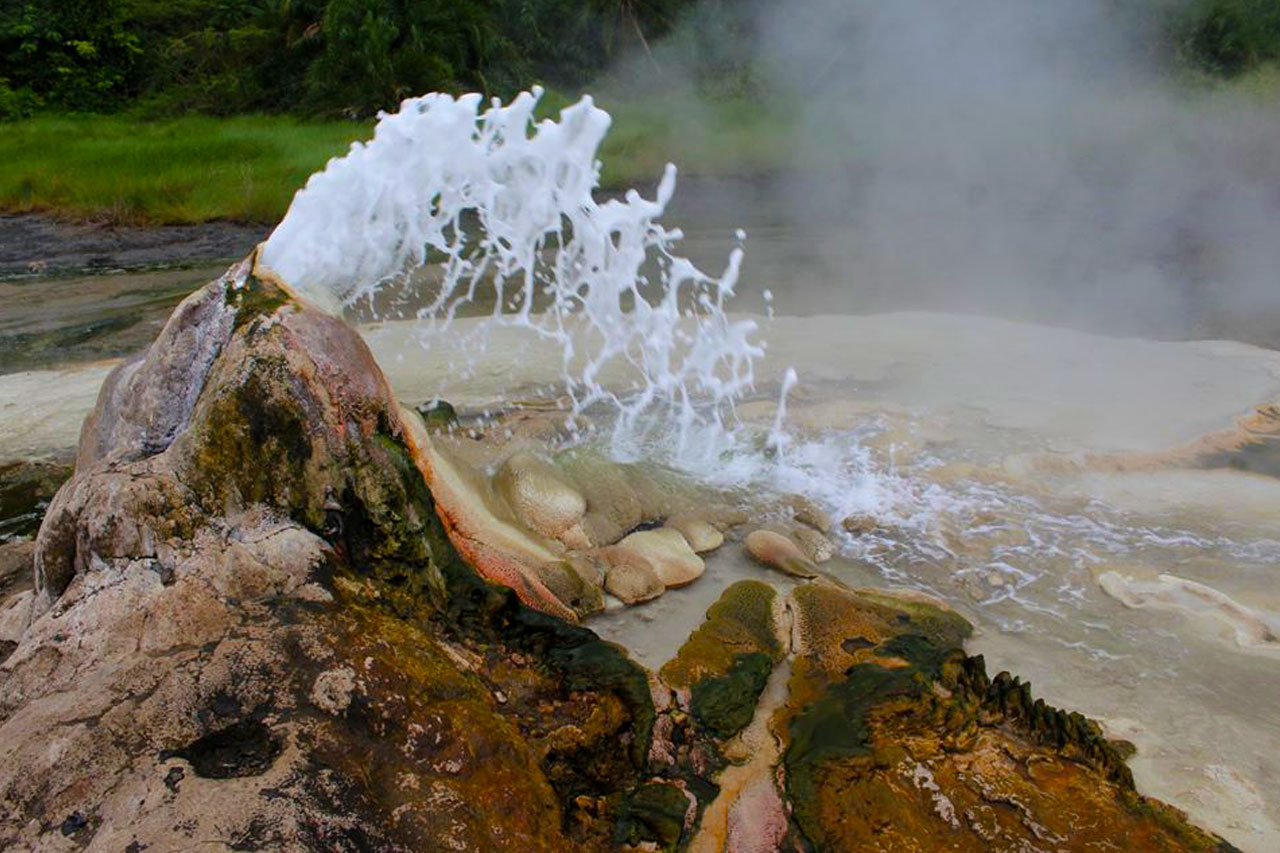
Stop 4: Makondo fault
The Makondo fault is a NE-SW trending oblique slip fault dipping to the NW and displaying a transpressional positive flower structures at transfer zones. A horse tail structure is interpreted on Iknois satellite data from Semliki basin corresponding NE termination of Makondo fault.
After stop 4, delegates will drive and spend night in Fort Portal,
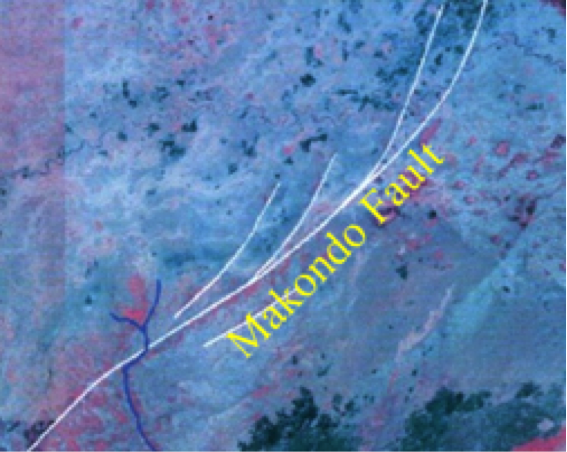
DAY 2: GEOLOGY OF LAKES EDWARD AND GEROGE BASINS
These basins represent the Southern domain of the Albertine graben and trends in the NNE-SSW being the dominant trend and the NNW-SSE trends being minor. The two sub-basins are generally two opposing half grabens with the major boundary fault on the Congo side, the NNE-SSW trending Lubero Fault controlling the area of maximum subsidence coincident with the present-day location of Lake Edward. Lake Edward is connected to Lake George by Kazinga channel which is believed to be a remnant of an older river that drained westwards.
Delegates will depart from Fort Portal at 7.00am and drive to Lake Edward-George basins.
Stop 5 and 6: Bunyaruguru Crater Lakes
The western arm of the East African rift system is essentially amagmatic. Volcanic provinces are aerially and volumetrically small leaving the majority of the western rift devoid of magmatism. In the Albertine graben, two volcanic provinces of quaternary age have been observed; the Katwe-Kikorongo and Bunyaruguru-Fort Portal provinces. At Bunyaruguru, several crater lakes and volcanic ash are evident.
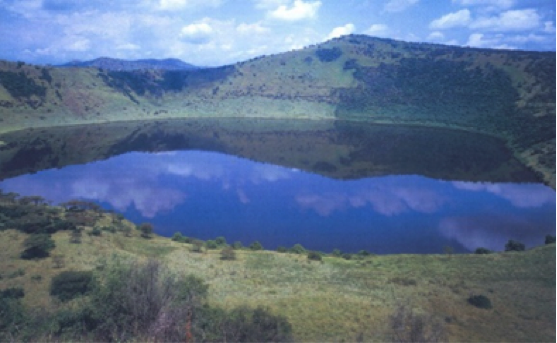
One of the crater lakes in the basin The volcanic rocks mainly tuffs and ashes are beautifully exposed in the vicinity of the recent explosion craters as well as along the eastern basin margin faults. Some of the tuffs can be seen in some locations to have been folded by later Neogene compression regime. Delegates will depart for a night in Mweya safari lodge.
DAY 3: GAME DRIE IN QUEEN ELIZABETH NATIONAL PARK (08:00 - 11:00 HRS)
Queen Elizabeth National Park (QENP) covers an area of 770 sq. miles (1995sq.km). Road access from Uganda’s capital city of Kampala is 206 miles (420km). By air, it can be accessed through the landing strip at Mweya Safari Lodge for light aircraft or a larger airstrip at Kasese town. QENP lies in the fertile equatorial area that is especially scenic, with two lakes connected by a channel overlooked by a high peninsula. It also has volcanic craters, grassy plains and tropical forest with high biodiversity rating in the world. Formerly called the Rwenzori National Park, QENP returned to its royal colonial name. The wide bio-diversity contains the most astonishing number of species-almost 100 types of mammal and 606 different birds, with Kazinga channel alone housing the world’s largest concentration of hippos.

Other wildlife includes; warthogs, buffaloes, rare aquatic sitatunga antelopes, beautifully horned Uganda kob, giant forest hog, waterbuck, topi, elephant, leopard etc. Kyambura (or Cham-bura) gorge on the northern eastern boundary of the park has thick canopies and vines dangling down to the soft forest floor inhibited by chimpanzees. The Maramagambo forest, south of the Kazinga channel is home to a large number of chimpanzees plus a number of other monkey species.
The pouting shoebill (or whale-headed) stork and myriad of other birds and mammals are best viewed from a boat on Kazinga channel. Specialties at QENP include a beautiful sunset over the water, warthogs and hippos mowing the lawn at the Mweya Safari Lodge, boat ride on Kazinga channel, chimpanzees in Kyambura/Chambura gorge and beautifully positioned safari lodges.
Delegates will set off for Kampala at 11:00Hrs
Fees: US$900 per person.
Costs include transport, accommodation, meals and park fees. Delegates should ensure they carry appropriate field gear e.g. field boots.
Contact:
Tonny Sserubiri
Principal Geologist/Exploration
Petroleum Exploration, Development and Production Department
21-29 Johnstone Road. P.O. Box 9, Entebbe/Uganda
Office: +256 414 320714
Fax: +256 414 320437
Mobile: +256 781163590/703463009
Email: This email address is being protected from spambots. You need JavaScript enabled to view it.
